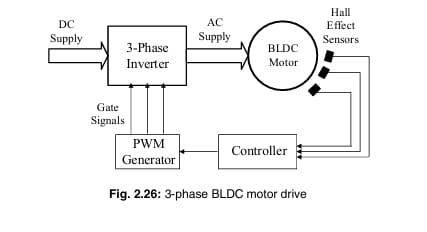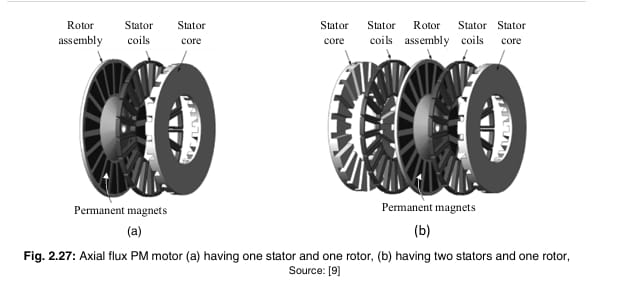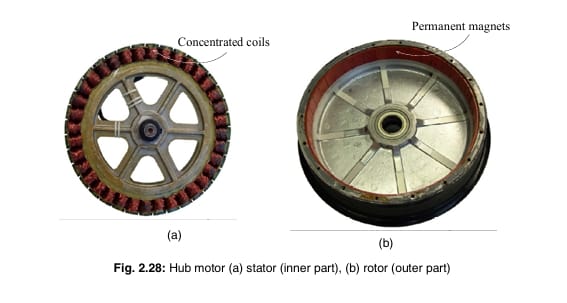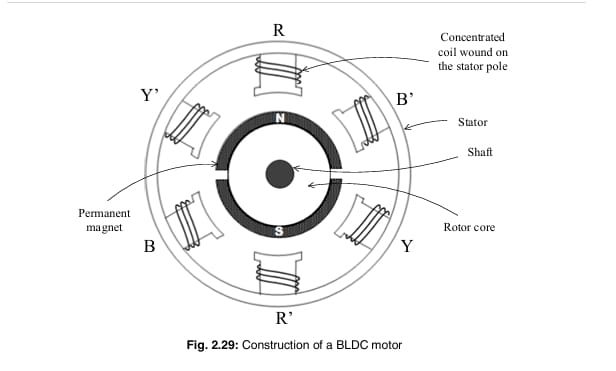Table of Contents
Brushless DC (BLDC) Motor
Brushed DC motors are older types of motors that utilize small components called brushes and a commutator to facilitate the flow of electricity. But these parts rub against each other and cause sparks, which makes them wear out quickly. They also have wires on both the inside and outside parts of the motor, which makes them more expensive. Even so, they’re still used in many factories because they work well and give a lot of power for their size.
Types of BLDC Motors come in different types. They all work in a similar way, but the parts inside can be arranged in different ways.
Brushless DC motors, or BLDC motors, are a newer and better version. You can find them in many things we use every day, like laptop fans, washing machines, and even electric cars and bikes. They’re also used in places like hospitals and airplanes.
As the name says, BLDC motors don’t have brushes. Instead, they use electronic parts to do the job. The spinning part (called the rotor) has strong magnets on it instead of wires.
These motors have lots of good features:
- They’re easy to control.
- They respond quickly.
- They save energy.
- They last a long time.
- They don’t make much noise.
- They can spin fast.
Because they give more power in a small size, they’re great for machines where space and weight are important.
But you can’t just plug a BLDC motor into a battery or wall socket. It needs extra parts to work. One of these parts is called an inverter. It changes the steady electricity into a kind that the motor can use. Another part helps the motor know its position so it can spin the right way.
Even though it’s called a DC motor, it works more like an AC motor. That means the magnetic parts inside move together at the same speed. This is different from some other motors where one part moves faster than the other.
To help imagine it, think of a BLDC motor like a smart spinning machine. It gets power from an electronic box (called a drive), which sends the right signals to make it spin smoothly and efficiently.

Types of BLDC Motors
BLDC motors are part of a special motor family that uses strong magnets. These magnets are fixed on the rotor, which is the part that spins.
But there’s something different about how the wires are placed in the stator, the non-moving part of the motor. There are two main types of BLDC motors based on this:
- Sinusoidal Type:
- The wires are spread out smoothly all around the stator.
- This makes the voltage (called back EMF) look like a smooth wave.
- These motors are called Permanent Magnet Synchronous Motors (PMSM).
- Trapezoidal Type:
- The wires are grouped closely together.
- This makes the voltage look more like a boxy wave, called trapezoidal.
- These motors are known as Brushless DC Motors (BLDC).
The wave shape of the voltage also affects how the motor runs. Sinusoidal motors have smoother current, so they spin more evenly. Trapezoidal motors can feel a little bumpier because of their shape, but they are easier to make and control.
Sinusoidal motors cost more because their wiring is more complex and uses more copper. BLDC motors are simpler, cost less, and are easier to use. That’s why BLDC motors are more common in many machines.
Voltage and Where They Are Used
- Small BLDC motors (48 volts or less) are found in electric bikes, robots, and toys.
- Bigger motors (100 volts or more) are used in home appliances, factories, and automation systems.
Types by Phases
BLDC motors can be:
- 1-phase
- 2-phase
- 3-phase (this is the most popular)
Three-phase BLDC motors are used the most because they are stronger, run better, and last longer.
So, in short, BLDC motors come in many types, shapes, and sizes. Whether it’s helping a toy move or running a big machine, there’s a BLDC motor made for the job!
BLDC Motor Types Based on Magnetic Flow (Flux)
BLDC motors can also be grouped based on how the magnetic force—called flux—moves between the stator (the part that stays still) and the rotor (the part that spins).

There are two types:
- Radial Flux Motors
- Axial Flux Motors (also called Pancake Motors)
1. Radial Flux Motors
In these motors, the magnetic force moves outwards from the center—like rays of the sun. This is called radial direction. When this magnetic field meets the electric current in the motor, it creates torque, which makes the rotor spin.
These motors are very common and are used in many machines because they are easier to make and work well for most jobs.
2. Axial Flux Motors
In axial flux motors, the magnetic force moves along the same direction as the motor’s shaft—from front to back. When this force meets the electric current, it also creates torque.
These motors are built in a compact, layered way. Think of them like a sandwich, with the stator and rotor stacked in layers (like bread and filling).
Why Axial Flux Motors Are Special:
- They are small and lightweight.
- They can produce a lot of power for their size.
- They can speed up and slow down quickly.
- The space (air gap) between the stator and rotor can be adjusted easily.
- The magnets don’t need extra support to handle the spinning force.
Where Are Axial Flux Motors Used?
Because they are powerful and compact, axial flux motors are used in:
- Airplanes and spacecraft
- Ships and boats
- High-speed vehicles like electric and hybrid cars
What’s the Catch?
Axial flux motors are more complex to make and assemble. That’s why we don’t see them everywhere yet. But as technology gets better, they are becoming more popular.
In short:
- Radial flux motors are simple and commonly used.
- Axial flux motors are small, strong, and great for high-performance machines.
types of BLDC Motor on Rotor Position
A long time ago, DC motors used brushes and a commutator to work. These motors had magnets on the outside part (called the stator) and coils of wire (called the armature) on the inside spinning part (called the rotor). This setup was needed because the brushes helped switch the direction of the current.
But after 1950, two big changes happened:
- Strong permanent magnets were invented, so we didn’t need big, heavy magnets with wires anymore.
- New electronic parts like SCRs and IGBTs let us switch the motor’s current using electronics instead of brushes.
These changes led to the creation of new motors, including the BLDC motor (Brushless DC Motor).
In a BLDC motor:
- The rotor has permanent magnets.
- The stator has the wire windings where current flows.
- This design makes the motor easier to build and take care of.
Now, let’s look at two main types of BLDC motors, based on where the rotor is:
1. Inner Rotor Type
- The rotor is inside the stator.
- It is good for machines that need to spin fast and cool down easily.
- In electric vehicles (EVs), it is connected to the wheels with gears.
2. Outer Rotor Type
- The rotor goes around the stator.
- It is used in electric bikes, drones, water pumps, and home gadgets.
- In some EVs, this motor can be placed directly inside the wheel. It’s called a Hub Motor.
Why Hub Motors Are Great:
- No need for gears, which saves energy.
- Gives high torque, which helps the EV go farther.
Things to Keep in Mind:
- These motors get hot easily since the heat is trapped inside.
- They also make the wheel heavier, which can affect how the vehicle moves.

types of BLDC Motor on Position Sensors
- Sensor-Based Motor
- These motors use special sensors, like Hall-effect sensors, to know exactly where the spinning part (rotor) is.
- The sensor tells the controller when to turn on the right stator coil, so the motor keeps spinning smoothly.
- These motors work well at all speeds, even when starting from a stop.
- They are often used in electric cars, robots, and other machines that need smooth and accurate control.
- Sensorless Motor
- These motors don’t have any sensors. Instead, they guess the rotor’s position by looking at something called back EMF—a small voltage made when the rotor spins.
- The controller uses this guess to turn on the coils at the right time.
- Sensorless motors are simpler and cheaper, so they’re great for fans and pumps.
- But they don’t work as well at very low speeds or when stopping and starting quickly, because the back EMF is very weak in those situations.
Construction of Inner Rotor Type
An inner rotor BLDC motor is made of two main parts:
- Stator (the outside part) – This part stays still and doesn’t move. It looks like a round metal ring with small slots on the inside. Wires are wrapped and placed in these slots. When electricity flows through the wires, they create magnetic fields.
- Rotor (the spinning part) – This part is in the middle and spins. It’s shaped like a cylinder and fits inside the stator. There’s a tiny space between the rotor and stator called the air gap, so the rotor can spin freely.
The stator has metal parts called poles that reach toward the rotor. Coils of wire are wrapped around these poles. In a motor with two poles, the coils on opposite sides are connected and make up one phase. Most BLDC motors have three phases: A-B, B-C, and C-A. These phases help the motor spin smoothly.
The rotor has strong magnets attached to it. These magnets are picked based on how strong they need to be. In older motors, a type of magnet called a ferrite magnet was often used. They’re cheap, but not very strong.
In simple words, the stator makes changing magnetic fields, and the rotor follows them and spins. That’s how the motor works!

Types of Magnets and Rotor Designs in BLDC Motors
Some BLDC motors use special magnets called neodymium iron boron magnets (also written as NdFeB). These are rare-earth magnets, and they are super strong! They can create 20 times more magnetic power than older magnets like ferrite magnets.
Because NdFeB magnets are so strong, they help the motor produce more torque (twisting force) even if the motor size stays the same. That means stronger motors without needing to make them bigger!
Now, the way these magnets are placed on the rotor also matters. There are three common ways to put magnets on the rotor:
- Surface Mounted Type – The magnets are placed right on the outside surface of the rotor.
- Embedded Type – The magnets are hidden inside the rotor body.
- Inserted Type – The magnets are placed in special slots or holes in the rotor.
Each type changes how the motor performs. So, in short: stronger magnets like NdFeB make motors better, and how you place the magnets on the rotor helps decide how the motor works!

Working Principle of BLDC Motor
A BLDC motor spins using magnets! It works by using the push and pull between the magnets on the rotor (the part that spins) and the magnetic fields made in to the stator (the part that stays still).
Here’s how it works step by step:
- The stator has three groups of wires, it`s called phases.
- A device called an inverter sends electricity to these wires in a special pattern, one after the other.
- When electricity flows through the wires, they act like magnets. Depending on the direction of the current, they become either a north or south pole.
- These poles attract or repel the magnets on the rotor, making it spin.
- As the current moves from one set of wires to the next, the rotor keep turning smoothly.
This movement creates something called torque, which is just the force that helps the rotor turn.
The torque depends on things like:
- How strong the electric current is.
- How many loops of wire are in the stator?
- How powerful the magnets are.
- The small space (air gap) between the rotor and stator.
- How big is the rotor?
While the motor is running, it also creates a special type of voltage called back EMF. In BLDC motors, this back EMF has a shape like a trapezoid. To work well, the motor needs current that matches this shape.
To know when and where to send electricity, the motor uses Hall-effect sensors. These sensors help figure out exactly where the rotor is, so the inverter can send power at the right time.
The motor gives strong, steady torque up to a certain speed, called the rated speed. It can go faster—up to about 1.5 times the rated speed—but the torque gets weaker as the speed goes up.
If the motor needs to start and stop a lot or change direction often (like in electric cars or robots), it needs extra torque to get going. That’s why motors in these machines are designed to be even stronger than normal.
Difference Between BLDC and Brushed DC Motors
| Feature | BLDC Motor (Brushless) | Brushed DC Motor |
|---|---|---|
| Brushes | ❌ No brushes | ✅ Has brushes |
| Maintenance | Very low (fewer parts wear out) | High (brushes wear down) |
| Lifespan | Long-lasting | Shorter life due to brush wear |
| Efficiency | Very efficient | Loses more energy as heat |
| Noise | Very quiet | Noisy because of brush friction |
| Speed Control | Smooth and accurate | Less smooth |
| Cost | More expensive | More affordable |
| Control System | Needs electronic controller | Can run with a basic switch or battery |
✅ Advantages of BLDC Motors
- No Brushes – No friction from brushes means quieter operation and less wear and tear.
- Low Maintenance – With fewer moving parts, there’s less that can go wrong.
- Long Life – BLDC motors are durable and don’t wear out quickly.
- Energy Efficient – They use electricity more effectively, so they stay cooler and save power.
- Smooth Speed Control – Perfect for applications that need precise speed, like fans or electric vehicles.
- High Torque – Strong performance even at low speeds, which helps in lifting or moving heavy loads.
⚠️ Disadvantages of BLDC Motors
- Higher Cost – The motors and their electronic parts can be more expensive.
- Needs a Controller – You can’t just plug them in; they need a special electronic controller.
- More Complex – They rely on sensors and software, which makes them harder to understand.
- Difficult to Repair – If something breaks, fixing it often requires special tools and knowledge.
🧠 Final Thoughts
BLDC motors may cost more and be a bit more complicated, but they’re powerful, quiet, and built to last. That’s why they’re used in electric cars, drones, appliances, and many other smart machines. If you want something that works efficiently and lasts a long time, BLDC motors are a great choice!
FAQ
What is a BLDC Motor?
A BLDC motor (Brushless DC motor) is a type of electric motor that uses magnets to spin. Unlike older motors, it doesn’t have brushes. That means it runs quietly, works smoothly, and lasts longer.How does a BLDC motor work?
When electricity flows through the motor’s coils, it creates a magnetic field. This field attracts or repels the magnets in the rotor, making it spin. A controller switches the electricity to the right coils at the right time to keep the rotor moving smoothly.What’s the difference between Sensor-Based and Sensorless BLDC motors?
Sensor-Based Motors: Use tiny sensors to find the rotor’s exact position.
Sensorless Motors: Don’t use sensors. Instead, they estimate the rotor’s position using signals from the motor itself.Which is better: Inner Rotor or Outer Rotor BLDC motors?
It depends on what you need:
Inner Rotor Motors: Best for fast spinning and small size
Outer Rotor Motors: Best for strong power at low speeds, like in electric scooters and e-bikes. Are BLDC motors better than brushed motors?
Yes, in most ways! BLDC motors are stronger, quieter, and last longer. But they can cost more and need special electronics to run.
